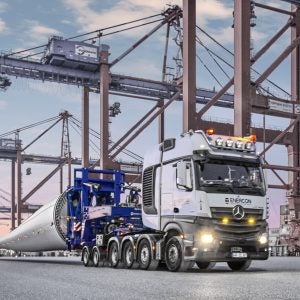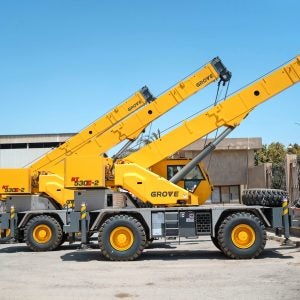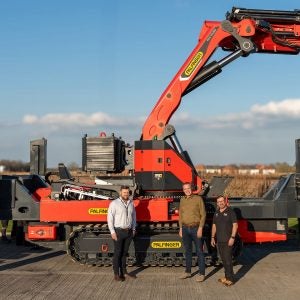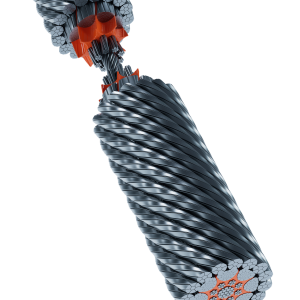ConnectingCranes can exclusively reveal details of Link-Belt’s new 300 US ton (272t) capacity LS 348 H5 crawler crane. The first photo of this machine is on the cover of the June issue of Cranes Today magazine.
The LS 348 H5, which lifts 300 US ton (272t) at 15ft (4.6m), is the biggest machine in Link-Belt’s range. While the headline capacity rating suggests that it is in the same class as the 300 US ton Manitowoc 2250, it is in fact being marketed more against (and priced below) the 275 US ton (250t) 999, and also against the new Terex Demag CC 1500 (seen at Intermat) and the Liebherr LR 1280. And while the LS 348 H5 doesn’t generally outlift the beefy 2250 it has features that might tempt customers looking for a lower cost option.
The LS 348 H5 is a wholly new machine, not based on an existing Japanese crane in parent company Sumitomo’s range. It has been developed by Link-Belt and Sumitomo engineers together specifically for the North American market. The boom and mast are made by Link-Belt in Lexington, Kentucky; everything else is shipped over from Sumitomo Heavy Industries in Nagoya.
Main features of the boom system are: • 70ft (21.3m) basic heavy duty boom (in four sections) • 300ft (91.4m) maximum heavy duty boom • 85ft (25.9m) basic long reach boom • 355ft (108.2m) maximum long reach boom • 425ft (129.5m) maximum luffing attachment (205ft boom + 180ft luffer + 40ft fixed jib).
While the boom system is not compatible with other Link-Belt cranes (Manitowoc, in particular, pushes boom system modularity as a selling point), sections of the long reach boom will be modular with other models yet to be unveiled, says Link-Belt’s product manager for lattice boom cranes, Pat Collins.
One of the key features of this new machine is a patented system, called Max Trax, for widening its footprint, allowing it to be ‘skinny’ where space is a consideration, or ‘fat’ where space is available and greater capacity is required. In either configuration the base rating is the same, but there are differences through the chart of about 20%. It is not unusual for smaller crawler cranes to use a hydraulic cylinder to push the crawler tracks away from the centre of the crane, but such a feature is not feasible on this size. The LS 348 H5 has the same narrow gauge as the 999 when ‘skinny’ – 19ft 2in (5.8m) – but the crane can also be assembled with a patented extender block (also called spacer block) in the carbody side frame to widen the gauge to 22ft (6.7m). The success of the 999 is due, in significant part, to its narrowness, says Collins. ‘We want to be able to outpick it and get in anywhere it can,’ he says. The length of the crawler tracks is 30ft 8in (9.3m).
Self-assembly is achieved by using a single hydraulic cylinder that is mounted in the live mast. The counterweight removal system, operable by remote control, takes the entire 223,000 lb (101t) of rear counterweight in a single package and it sets it on the ground with no blocking required. Full counterweight comprises 13 sections, each of which can travel with bits of boom section to minimise loads. The counterweight removal system can itself self-detach if necessary – in regions ultra-sensitive to weight perhaps. An additional 75,000 lb (34t) of counterweight is built into the lower, with three pieces at the front and three at the rear.
The whole machine is powered by a 350kW/470hp Isuzu diesel engine. (The Manitowoc 2250 has a 335kW/450hp engine and the 999’s is 291kW/390hp). Line pull is 55,000 lb (25t) on the front and rear drums. Line speed is 565fpm (172.2m/min).
Options include freefall front and rear drum, third drum in the boom base and rear mounted fourth drum.






